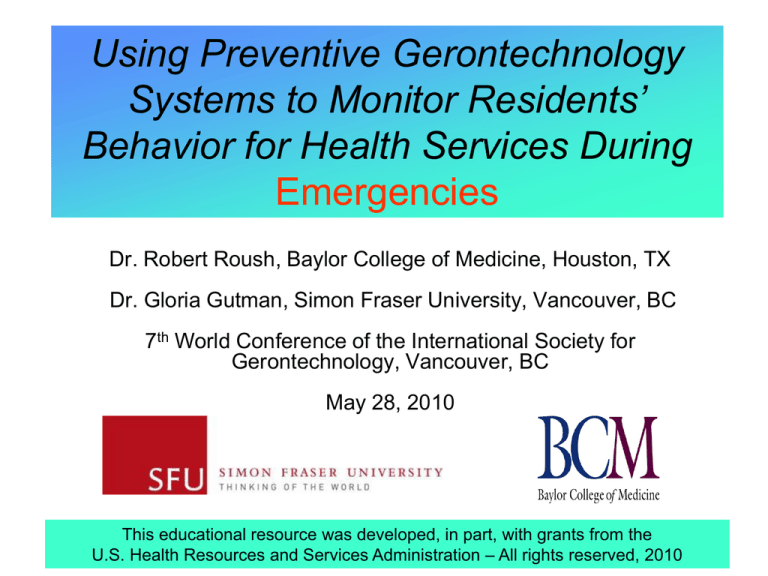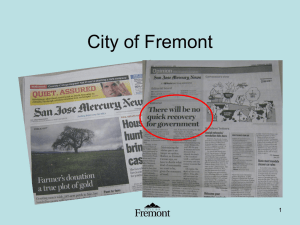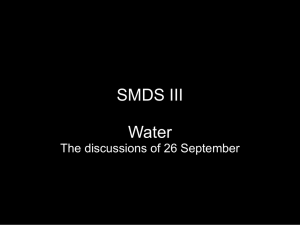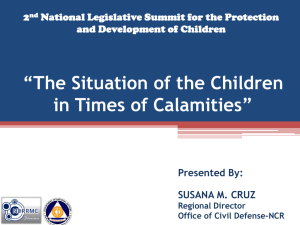
Using Preventive Gerontechnology
Systems to Monitor Residents’
Behavior for Health Services During
Emergencies
Dr. Robert Roush, Baylor College of Medicine, Houston, TX
Dr. Gloria Gutman, Simon Fraser University, Vancouver, BC
7th World Conference of the International Society for
Gerontechnology, Vancouver, BC
May 28, 2010
This educational resource was developed, in part, with grants from the
U.S. Health Resources and Services Administration – All rights reserved, 2010
Our Wonderful World Is Also a
Dangerous Place
Anthrax
2001
SARS
2003
Tsunami
2004
Bombings 2005
Hurricanes 2005
Avian Flu
2006
Swine Flu
2009
Earthquake &
floods
2010
September 11, 2001
Is health care prepared? Are you?
What’s next? ‘11
Global Aging
1.2 billion older people worldwide in 2025
70% will be in developing countries
1 million people turn 60 monthly worldwide now!
12,000 persons in the U.S. turn age 62 daily!
1st of 77 million U.S. boomers turn 65 in May 2011
Context and Perspective – GEPR
Older persons have altered levels of
immune function
Higher risk of infectious illness and
reduced response to antibiotics
Few health care workers have had
adequate training in disaster planning
Even robust elders have a greater
risk in natural disasters
We need all-hazards approach to
geriatric emergency preparedness
and response – GEPR
Technology can play an important
role in mitigating effects of disasters
Topics for This Program
Need for disaster training
Preparedness issues
Diagnosing & treating older adults
Bioterrorism and emerging infections
Natural disasters, evacuation or shelter
in place
Communications and technology
Reverse alerts to PERS subscribers
Need for Local Training in GEPR
Heat waves – France
Extreme cold – England
Floods – Manitoba and Nashville, TN
Wild fires – Australia and California
Tsunamis – S. Asia
Earthquakes – Haiti
Hurricanes – Katrina, Rita, Wilma, and Ike!
Avian Influenza (H5N1), then Swine Flu (H1N1)
Weaponized biological agents
Your hometown
Your family
Your residents/patients
Need for National Training in GEPR
<50% health care workers have had
bioterrorism and emergency preparedness
training, only 1 in 10 have had geriatricsspecific training
Health care workers, acute and LTC
administrators, 1st responders & receivers,
and ED staff need training in treatment and
geroethics of triage, regardless of type of
disaster – whether natural or human-caused
Need for International Training
GEPR – Geriatric Emergency
Preparedness & Response issues
are global …since 1995, heat
waves, extreme cold, and floods in
Europe plus earthquakes and
weather-related disasters around
the world have killed almost a
million with over 2.5 billion people
affected and costing $738 billion
in US dollars .
Older people are always among
those disproportionately affected.
The Public Health Agency of
Canada’s Division of Aging and
Seniors has started a global
initiative on GEPR issues.
Canadian-led Initiatives in GEPR &
PERS
1st meeting of International Work Group on Emergency
Preparedness held in Washington, D.C., in 2005
Subsequent international conferences sponsored by the
Public Health Agency of Canada/Division of Aging and
Seniors held in Toronto, Winnipeg, Halifax, and Paris
Regular teleconferences of the IWG on EP
Research projects funded on GEPR tools used in LTC
facilities and on use of PERS in disaster mitigation plans
Our Role in Emerging Threats
Think “pre-event” preparedness
Develop local relationships
Education and training
Communicate to our
patients/public
–
–
–
–
–
–
What is their risk?
What is being done to protect them?
How can I protect myself?
How can I protect my colleagues?
What else do we need to know?
Which technology can help?
RB McFee, 2004
The Disaster Cycle Today
What You Need to Know and Can
Do Regarding All Hazards
What is the threat?
What are the vulnerabilities?
What special geriatric preparedness issues
need to be addressed?
What needs to be done?
What can we do now?
– conduct community risk assessments
– train, train, train
– empower seniors
– take preventive actions
– use communications and technology
Understanding, Diagnosing, and
Treating Older Adults
Common Age-Related Changes
Homeostatic ∆s
Baroreceptors – postural, hypotension, syncope
Thermoregulation – hypothermia
cardiac reserve – fluid overload
Renal perfusion – nocturia, drug
toxicity
Barrier ∆s
Skin – thinner barrier with reduced blood flow
Lungs – less active cough reflex
Stomach – reduced gastric acid
CNS – absence of fever
Immune system – reduced cell-mediated immunity
Older People Show Less Response to
Severe Infections
Patients with pneumoccocal
infection where the bacteria grew
from their blood.
>65 were more frequently without
fevers, had lower peak
temperature, and had higher
mortality.
Screening for infection in older
people can’t have absolute
temperature cutoff = many will be
missed.
Less response does not mean less
severe infection.
Gleckman, 1981, Chassagne, 1996
Clinical Features by Age:
20-49 50-64 65+
Unclear History
12%
23%
44%
Temp <100
9%
15%
29%
Peak Temp
104
103
102
WBC<10,000
26%
40%
34%
Mortality
14%
32%
44%
Human-caused Disasters: BNICE
Biological weapons
Nuclear/radionuclides
Incendiary devices
Chemical agents
Explosive materials
Source: RB McFee, 2004
Natural Disasters
Basic needs: shelter, fuel,
clothing, bedding, household
items
Mobility: incapacity, transport
Health: access to services;
appropriate food, water,
sanitation; psychosocial needs
Family and social: separation,
dependents, changes in social
structure, loss of status
Economic and legal: income,
information, documentation
Source: HelpAge International. 2001. “Older People in Disasters and Humanitarian Disasters:
Guidelines for Best Practice.” Available online as a pdf file:
http://www.reliefweb.int/library/documents/HelpAge_olderpeople.pdf .
Emerging Infections: SARS in Toronto
Outbreak of SARS, early March 2003: 1st case
diagnosed March 13, peaked mid-March;
resurgence early May with peak in mid-May;
ended mid-June
March 28th Baycrest received a directive (Code
Orange) to take SARS prevention measures
>15,000 persons underwent voluntary
quarantine in greater Toronto area
44 deaths,100 health care workers infected, 3
deaths
M. Gordon, 2006
Preparedness Issues
The Four Pillars of GEPR
Today
Mitigation – identifying threats and resources,
taking preventive actions
Preparedness – planning, training + exercises
Response – acting decisively with Incident Command
structure
Recovery – getting back to normal, feeling safe again,
analyzing response mode for next event
Key: How many health professionals have been
trained for disasters where you live?
Natural vs. Human-caused Disasters
Similar concerns for frail elders whose lives are
disrupted by hurricanes, floods, wild fires, power
outages
Could experience interruption of home care services
if damage is widespread and large numbers of
people are affected – i.e., their informal caregivers
Even robust elders are affected more than younger
people in times of natural disasters
Same concerns for making people feel safe again
Evacuation vs. shelter-in-place decisions
Source: Fernandez, LS, et al., Prehosp Disast Med 2002;17(2):67-74
Roles and Responsibilities:
Pre-event Public Health Emergency
Public Health
Disease surveillance
Respond to outbreaks
• Investigation
• Control and
prevention
Laboratory support
Participate in planning
activities
Training
Assess for
communications
technology
D. Lakey, 2004
Hospitals & Health Care
Workers
Disease reporting
Immediately notify public health
of unusual group expressions of
illness or outbreaks
State laboratory utilization
Participate in planning activities
Exercise plans
Training
Know where frail elders live and
what their special needs are
Roles and Responsibilities:
During a Public Health Emergency
Hospitals & Health Care Workers
Implement notification protocols
Activate staff
Implement response plans/guidelines
Coordinate efforts with public health
Provide care
Coordinate health-related information
– public health officials
– citizens
– media outlets
– check on communications with elders
D. Lakey, 2004
Roles and Responsibilities:
Post-Event Public Health Emergency
Public Health, Hospitals & Health Care Workers
Evaluate response
Review after-action reports
Coordinate/implement changes to plans and procedures
Implement recovery plans
Determine if communications technology worked
D. Lakey, 2004
Overview of American Society on Aging
Article in Healthcare and Aging
1st step – knowing where our frail elders are before, during, and
after disaster
2nd step – training frontline health care providers on how older
people present differently
3rd step – teaching all-hazards approach on physical, mental,
and psycho-social issues
4th step – ensuring that providers know about culturally and
linguistically appropriate communication strategies and services
5th step – making sure health care providers and older persons
are involved in planning for such practical considerations as
evacuations, shelters, and receiving emergency alerts
25
Communications and Resources
Challenges to Aging in Place
Gerontechnology can be used to assess well-being
Expensive “smart homes” to inexpensive devices
Activities of Daily Living Reporting Systems
e-ADLRS gather data on elders’ routine home activities
Wireless motion and light sensors upload data
Establishes baseline, looks for marked changes
Clients sent reports via website, e-mail or phone
Possible problems checked out sooner
Receiving reverse alerts from PERS in emergencies
PERS Helps Elders….
Live safer and more independently in their homes longer by:
Alerting caregivers to emerging problems, thereby reducing risks
of hospitalization
Providing “circle of safety” via e-ADLRS integrating PERS &
motion sensor monitoring + bi-directional communications 24/7
Recognizing and better understanding resident/patient condition
Facilitating eldercare agencies to fill gaps in coverage and direct
care where most needed
Reducing anxiety of and burden on family caregivers
Mitigating effects of disasters
Indications for Smart Home Technology
What are the leading medical indications – CVD,
frequent faller, recent hospitalization?
What are the main social indications – living alone,
no informal caregivers nearby, can’t afford in-home help?
What criteria should be used in writing an environmental
Rx for e-ADLRS monitoring?
Is the SmartHT bundled with a reverse-alert PERS?
Smart Home Technology for Telecare
Sensors
Only required information
leaves home
Local
Intelligence
Why PERS, e-ADLRS & GEPR?
Congregant care communities are where
the density of elders at risk is far higher than
among community dwelling elders
24/7 emergency response and motion-bylocus monitoring systems help mitigate risks
of elders harmed in disasters when systems
have bi-directional communications capability
Mitigation requires interoperability between
caregivers, both at a distance and those on
site
Funded Study on PERS in GEPR
DAS contracted with Sandra P. Hirst, RN, PhD, GNC(C), Director,
Brenda Strafford Centre for Excellence in Gerontological Nursing,
University of Calgary, for a 3-phase environmental scan to determine
the state of PERS services used to mitigate harm to elders in disasters
1. Literature scan on general uses of technology in personal and large
scale emergency settings to understand key technical and nontechnical considerations and hence criteria for study’s assessment
2. Detailed survey of North American PERS providers, to understand
product capabilities and variations in technologies, target clients, and
patterns of communication
3. Contacted PERS providers to obtain company assessments of
the actual and potential benefits of their systems in disaster settings
Assumptions of Study on PERS &
GEPR
PERS system support in disasters settings would have these minimum capabilities:
Be able to reach all the targeted individuals
Allow broadcast of specific messages to a targeted set of individuals
Permit local authorities to provide messages for distribution
Putative benefits of PERS systems for disaster situations were these:
PERS have databases of client information, including medical information and
chains of contacts for both caregivers or family and the entire caregiver network
PERS technology designed to accommodate older adults with special needs,
e.g., large buttons, lights or audio accessories for those with hearing impairment
PERS technology is accessible to and accepted by older adults and
communications/systems infrastructure is in place.
Results of Study on PERS & GEPR
SWOT analysis of 28 PERS companies
revealed:
PERS communications systems are not
generally designed for mass broadcast
PERS on-person alert devices are
usually not designed for incoming notices
Geographic coverage is fragmented:
a
region may be covered by multiple PERS
providers, resulting in even greater difficulty
for local a authority to distribute messages
No existing channels for
local authorities
to communicate with PERS providers
Recommendations for PERS use in
Disasters
Demographics
Assess percentage of seniors using PERS to solicit response in personal medical
emergencies and coverage of providers
Plan for next generation of seniors or their caregivers who will be looking for
PERS with such enhanced capabilities as wide-area coverage, global positioning
Technical aspects
How can current technologies such as GPS, and cellular voice & data services be
packaged into simple, effective devices easily usable by seniors with a variety of
age-related limitations?
What data flows will be needed between PERS and other agencies so PERS can
participate as fully as possible in an overall disaster management setting?
Non-technical aspects
What information security, privacy, and regulation considerations are needed for
private companies to play key roles in overall disaster management?
Center for Aging Services
Technologies – CAST
CAST Members with Reverse Alert
Capability
CAST director Majd Alwan, PhD, in a personal communication on
May 14, 2010, stipulated that, to his knowledge, only two PERS
companies have reverse alert capability <malwan@agingtech.org>.
Touchtown’s e-Notify system was recently used to warn residents
of Holley Creek Retirement Community near Denver, CO, to take
appropriate action as they were in the path of a tornado.
http://www.touchtown.us/welcome/products/safety-devices.aspx
Wellcore’s bi-directional communication capability converts text
messages to voice, forwarding them to residents regarding upcoming events. While not used yet for disaster messages, the “on
the go” feature uses GPS with compatible mobile phones to locate
residents should they leave the facility for any reason.
http://www.wellcore.com
Touchtown’s e-Notify System
Touchtown Command Center Showing
Location of Unit Acknowledging “OK”
Wellcore’s Bi-directional
Communications Capability
Wellcore’s “On-the-Go” Feature Uses
GPS and Residents’ Mobile Phones
Online Resources 1
Center for Aging Services Technologies (CAST)
http://www.aahsa.org/article_cast.aspx?id=10235
International Community on Information Systems
for Crisis Response and Management
http://www.iscram.org/index.php?option=com_front
page&Itemid=1
WHO Report, A Safer Future: Global
Public Health Security in the 21st Century
http://who.int/whr/2007/en/index.html
Online Resources 2
Decision-making Criteria for
Evacuation of Nursing Homes
– http://www.fhca.org/emerprep/eva
csurvey.pdf
GAO Report on Evacuation of
Hospitals and Nursing Homes
Due to Hurricanes
– http://www.gao.gov/new.items/
d06790t.pdf
Older people in disasters and
humanitarian crises: Guidelines
for Best Practice
– http://www.helpage.org/Resources
/Manuals
Online Resources 3
Public Health Agency of Canada Pandemic Flu
Plan
http://www.phac-aspc.gc.ca/ep-mu/index.html
U.S. Department of Health and Human
Services: Disasters and Emergencies
http://www.hhs.gov/emergency
U.S. Centers for Disease Control and
Prevention - Pandemic and Avian Flu
www.pandemicflu.gov/
Online Resources 4
U.S. Agency for Healthcare Research and Quality:
Disaster Response Tools and Resources
http://www.ahrq.gov/path/katrina.htm
U.S. Federal Emergency Management Agency – Metropolitan
Management Resource Centers
http://www.mmrs.fema.gov/
Baylor College of Medicine & American Medical
Association – “Best Practices for Managing Elderly
Disaster Victims”
http://www.bcm.edu/pdf/bestpractices.pdf
Summary
Healthcare workers must have mitigation training
for all disasters, natural & human-caused
HCWs need to have training for each vulnerable
population – the young, the old, the disabled
HCWs need to remember that we’re always in the
pre-event mode of the next disaster
GEPR planning & frequent exercises required
Need reverse alert capability via PERS
Smart Homes of the Future: Aging
Trekkie Welcomes R2D2
Contact Information for GEPR/PERS
Issues
Dr. Robert E. Roush
Huffington Center on Aging
Baylor College of Medicine
One Baylor Plaza, MS230
Houston, Texas 77030
(713) 798-4611; www.bcm.edu/hcoa
rroush@bcm.edu;









